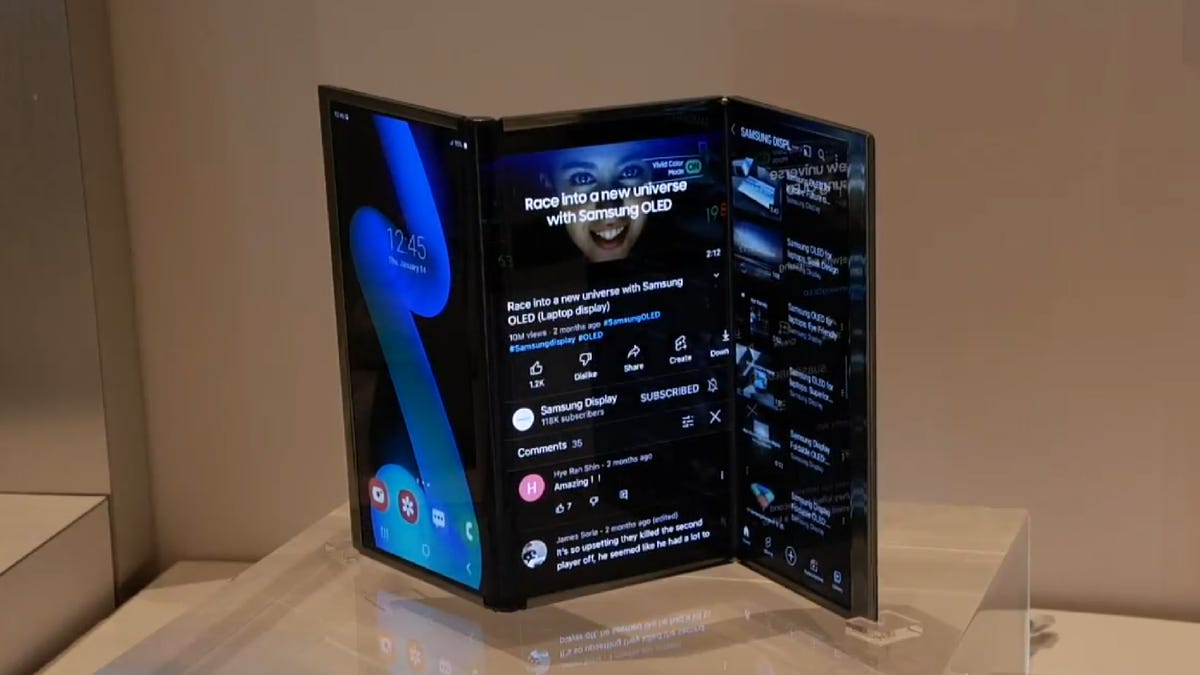Samsung's foldable concepts at CES 2022 revive dreams of tri-folding tablets and phones
Samsung Display revealed working foldable concepts on the CES 2022 show floor, but will they make it to market?

Samsung Display revealed several foldable concepts at CES 2022, including the Flex S tablet shown here.
While Samsung's CES 2022 keynote stressed sustainability and a handful of home gadgets, it saved its real next-gen tech for the show floor. There was where Samsung's Display division revealed several working foldable concepts which could lead to new phone and tablet designs in the future.
After more than a decade of flat phones that largely look alike, new designs are exciting, especially since the only non-flat devices sold today are phones the Samsung Galaxy Z Fold 3 and clamshell Samsung Galaxy Z Flip 3. Those third-generation foldables have more screen area relative to how compact they can be, but they've become conventional. These new Samsung CES concepts show other ways to achieve the same goal of fitting more screen area into the same-size devices.
What's more: They appear to be functional products with working screens and operating systems, leading us to wonder whether they're more likely to end up in the next round of flexible-display devices than foldable concepts we've seen from TCL and other manufacturers.
I wasn't on the ground at CES 2022 to judge the concepts in person, leading me to rely on video demonstrations recorded by Samsung. The company's mobile team did not respond to comment on which (if any) of the concepts could make their way into the company's product lines, and Samsung's Display division wouldn't provide specs on the concept devices nor confirm if they were running actual OS software.
Samsung's concepts: tri-folds, slides, and folding laptops
Samsung Display showcased four concepts on the CES show floor. The Flex S folds up into an 'S' shape, keeping part of the display on the outside. The Flex G also has two hinges, but the left and right segments fold into the center, protecting the inner screen.
The Flex Note is a more traditional single-hinge design, but with two tablet-sized segments that unfold flat to a combined screen size big enough to compare with modest computer monitors. Samsung's video showed it operating like a laptop with touch controls on the bottom half, which is exciting for anyone who wants to upsize the Z Flip 3 to the personal computing level, though the newly-revealed Asus Zenbook 17 Fold has beaten this concept to the market.
The fourth Samsung concept, called the Flex Slideable, looks like a normal phone until you extend the screen to the right with an unrolling motion. In the video, the screen only stretches out an inch or two more, but it's enough extra display to fit two columns of app icons. You could swap to another app without having to navigate to the home screen first.
More easily swapping apps may seem like a small benefit for the trouble of developing an entirely new screen-unrolling mechanism, but the point of flexible displays is to liberate phone design from the convention of flat screens on rectangles. Innovation continues in software, but even the latest iOS 15 and Android 12 updates haven't changed much about how we use our phones, so developing new hardware may be the only way we dramatically advance our phones and tablets.
Getting more display area by unrolling or unfolding is appealing for consumers to use multiple apps at once or enjoy media on a bigger screen. These CES concepts deliver on that ambition, developing ways to expand screen size before compressing into form factors that fit in pockets and purses.
Will these concepts make it to the market?
It's tough to gauge whether Samsung will ever bring these next flexible-screen to stores. If it does, getting consumers to notice will be another challenge.
It took three generations of Samsung foldables for consumers to buy Z Fold 3 and Z Flip 3 models in an estimated 9 million combined units sold in 2021, which is four times the number of Samsung foldables sold the previous year. Consumers are beginning to embrace a tried-and-true two-screen phone design. Will they embrace tri-folds?
It depends how much of Samsung's foldable development carries over to the new design and whether a tri-fold will be polished enough to avoid the durability and hinge failures that plagued the first Samsung Galaxy Z Fold back in 2019, which led to a half-year release delay. Samsung has repaired its foldable reputation, but who's to say whether new issues will spring up with another foldable design.
Also unknown is if consumers are ready for another design beyond the dual-screen foldable, especially in the larger tablet size seen in the Samsung concepts. But at least other companies are finding it promising enough to fast-track their own bigger-scale versions of the dual-screen, like the aforementioned Asus Zenbook 17 Fold. Several of these concept devices actually appeared in a Samsung Display promotional video released last May, so it does seem promising that the company built prototypes to show off at CES.
Perhaps Samsung won't be the first to sell a product in this new format, but showing working concepts of new flexible-screen designs shows us several contenders that could end up in our pockets one day – and maybe sooner, if other device makers see maturing folding and rolling tech as reason enough to test the market with a consumer-ready device.

